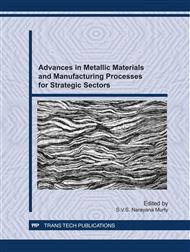p.500
p.506
p.511
p.516
p.521
p.527
p.533
p.539
p.545
Effect of Cold Working and Heat Treatment on Recrystallization, Mechanical Properties and Microstructure of High Strength Ti15V3Al3Cr3Sn (Ti-Beta) Alloy
Abstract:
Ti15V3Al3Cr3Sn (Ti-15-3-3-3) alloy is a highly cold formable metastable beta alloy and attains very high strength by proper selection of cold working and heat treatment cycles. Due to the presence of softer BCC beta phase at ambient temperature in solution treated condition, this alloy is highly cold workable; to as much as 90% without need of any intermediate annealing. In the present work, cold working up to 83% was imparted to the sheet. Subsequently, cold worked sheet was solution annealed at various temperatures. Cold worked and solution annealed samples were provided with two types of aging cycles: 482°C/16hrs/AC (STA-1) and 538°C/8hrs/AC (STA-2). Hardness measurement, tensile property and microstructural evaluation in cold worked (CW), CW plus solution annealed (CWSA) and CWSA plus aged conditions were carriedout. Recrystallization temperature has been observed to be dependent on extent of cold working. Tensile properties are higher for STA-1 cycle as compared to STA-2 cycle. Hardness values in cold worked condition are higher than solution annealed samples whereas for cold worked and STA samples, an increase in hardness w.r.t. to annealed values has been observed. Corresponding volume fraction of alpha precipitates is found to be more with STA-1 cycle than STA-2 cycle. Also, distribution of the precipitates with STA-1 cycle is observed to be more uniform than STA-2 cycle. The present paper discusses the effect of cold working on recrystallization, mechanical properties and microstructure in Ti-15-3-3-3 beta alloy.
Info:
Periodical:
Pages:
521-526
Citation:
Online since:
January 2012
Price:
Сopyright:
© 2012 Trans Tech Publications Ltd. All Rights Reserved
Share:
Citation:


